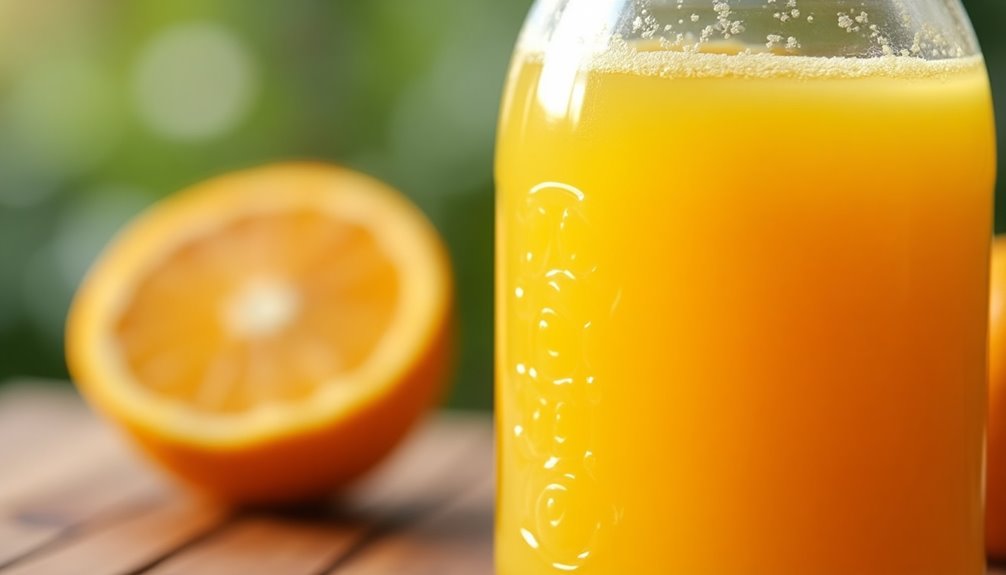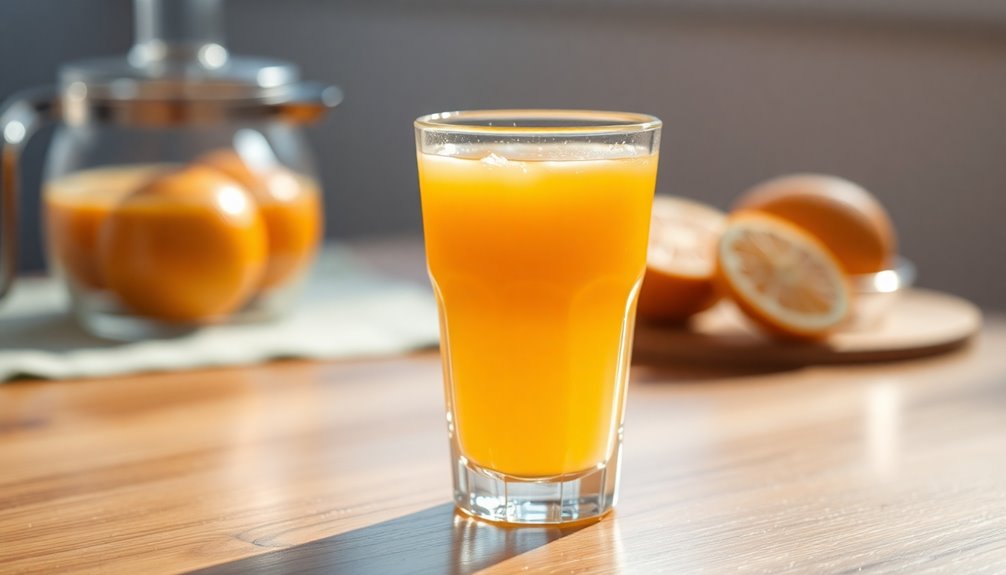Once you open orange juice, it stays good for about 7 to 10 days in the fridge. During this time, you'll enjoy the best flavor and nutritional value. After 10 days, quality decreases, so it's best to consume it quickly. If you freshly squeeze juice, drink it within 2 to 3 days to avoid spoilage. Remember to check for signs like foul odors or mold. There's more to know about storage and safety practices.
Key Takeaways
- Opened refrigerated orange juice typically remains good for 7 to 10 days for best flavor and nutrition.
- Freshly squeezed orange juice should be consumed within 2 to 3 days to prevent spoilage.
- Signs of spoilage include foul odors, visible mold, color changes, and bloated containers.
- To maintain freshness, store orange juice in a tightly sealed airtight container and refrigerate immediately after use.
- Discard orange juice left at room temperature for longer than 2 hours due to increased bacterial growth risk.

Have you ever wondered how long your orange juice stays fresh after you open it? It's a common question, especially if you like to enjoy a refreshing glass in the morning or use it in your favorite recipes. Understanding the shelf life of orange juice can help you make the most of your purchase and avoid wasting any of that delicious liquid.
After opening a refrigerated carton of orange juice, you should ideally consume it within 7 to 10 days to ensure it remains good to drink. This timeframe allows you to enjoy the juice while it retains its best flavor and nutritional value, but keep in mind that its quality starts to decline after this period. To extend the shelf life of your orange juice, always store it tightly sealed in the refrigerator at a consistent temperature. Additionally, when preparing fresh orange juice at home, you might wonder how much juice from 1 orange is typically obtained, as this can vary based on the size and juiciness of the fruit. On average, one medium orange yields about 1/4 to 1/3 cup of juice, making it a refreshing option when you need a quick, vitamin-packed drink.
Now, if you prefer freshly squeezed orange juice, you might want to take extra caution. Freshly squeezed juice has a much shorter shelf life, lasting only about 2 to 3 days in the fridge after opening. While it's undeniably tasty, its lack of preservatives means you need to drink it quickly. If you're planning to enjoy freshly squeezed juice, consider making smaller batches that you can finish within a couple of days to prevent spoilage.
When it comes to identifying whether your orange juice is still safe to drink, there are several signs of spoilage you should watch for. Foul odors, visible mold, changes in color, and a bloated container are all indicators that the juice has gone bad. If you notice any of these signs, it’s best to err on the side of caution and discard the juice. Trust your senses; if it doesn’t smell or look right, it’s not worth the risk. Additionally, always check the expiration date printed on the container, as consuming expired products can pose health risks. If you’re ever in doubt about whether the juice is still good, consider researching how to spell orange juice correctly; refreshed food safety knowledge can be just as important as identifying spoilage. Remember, your health is paramount, and it’s always better to be safe than sorry when it comes to potentially spoiled food items.
Another important factor to consider is how you store your juice. To maintain its freshness, always keep opened orange juice tightly sealed in an airtight container and refrigerate it immediately after use. This helps prevent exposure to air and bacteria that can speed up spoilage.
If you leave your opened orange juice out at room temperature, it's crucial to consume it within 2 hours. After that time, the risk of bacterial growth increases, and it's no longer safe to drink.
Frequently Asked Questions
Can I Drink Juice 2 Weeks After Opening It?
You shouldn't drink juice two weeks after opening it.
Even if it looks fine, the quality worsens significantly after about 7 to 10 days.
You might notice changes in taste, odor, or texture, which are signs it's no longer safe.
If you see any mold or unusual colors, toss it immediately.
It's always better to be cautious with perishable items, so check the juice carefully before deciding to consume it.
Can You Drink Orange Juice 10 Days After Opening?
You might think orange juice could last forever, but that's just not true!
If you've opened a carton of orange juice, you can safely drink it up to 10 days later, given it's been stored in the fridge.
Always check for any foul odors, visible mold, or strange color changes before sipping.
If it seems fine and smells good, go ahead and enjoy that refreshing taste without worry!
How Do You Know if Orange Juice Has Gone Bad?
To know if orange juice has gone bad, trust your senses. If it smells off, like vinegar, or shows visible mold, it's time to toss it.
A bloated container suggests gas buildup, indicating spoilage. Look for color changes; if it darkens or appears faded, that's a red flag.
Lastly, if the taste seems unusual, don't risk it. Always prioritize your health—when in doubt, throw it out!
Is Orange Juice Good After 7 Days?
After 7 days, you might notice that orange juice isn't as fresh or flavorful.
While it could still be drinkable, it's crucial to check for any signs of spoilage, like off odors or mold.
If you see any, it's best not to risk it.
For optimal taste and safety, try to consume your orange juice within the recommended timeframe.
Trust your senses, and don't hesitate to toss it if something seems off.
Conclusion
Once you open orange juice, its freshness starts to fade, usually lasting about 7 to 10 days in the fridge. To keep it at its best, always seal it tightly and check for any off smells or changes in color. Remember, the clock's ticking, so drink up! Visualize it like a ticking timer—every sip counts toward enjoying that vibrant flavor. So, savor your juice within the week for the best taste and quality!
Cindy thoroughly researches juicing trends, techniques, and recipes to provide readers with practical advice and inspiration. Her writing style is accessible, engaging, and designed to make complex concepts easy to understand. Cindy’s dedication to promoting the advantages of juicing shines through her work, empowering readers to make positive changes in their lives through the simple act of juicing.











